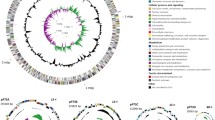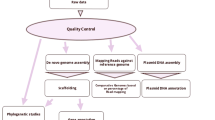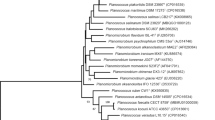Abstract
Genomic analysis of the catabolic potentialities ofSilicibacter pomeroyi DSS-3 against a wide range of natural aromatic compounds and sequence comparisons with the entire genome of this microorganism predicted the existence of at least seven main pathways for the conversion of the aromatic compounds to the intermediates which enter into TCA cycle, that is, the catechol (cat I andcat II genes) and protocatechuate (pca genes) branches of the β-ketoadipate pathway, the phenylacetate pathway (paa genes), the gentisate pathway (gtd genes), the homogentisate pathway (hmg/hppD genes), as well as the homoprotocatechuate pathway (hpc genes). Furthermore, the genes encoding those enzymes involved in the peripheral pathways leading to the β-ketoadipate central pathway were also mapped, i.e., 4-hydroxybenzoate (pob), benzoate (ben), quinate (qui), phenylpropenoid compounds (fcs, ech, vdh, cal, van, acd andact), tyrosine (hpp) and n-phenylalkanoic acids (fad). Evidences showed thatS. pomeroyi DSS-3 have versatile abilities to the catabolism of aromatic compounds either in anaerobic or in aerobic pathway, suggesting such a strain might be a model of heuristic value for the study of the genomic organization, the evolution of genes, as well as the catalytic or transcriptional mechanisms of enzymes for aromatic degradation in marine bacteria. Further, it would provide new insights into the biodegradation of aromatic compounds in marine bacteria and marine environments.
Similar content being viewed by others
References
Adachi K., Takeda Y., Senoh S., Kita H. (1964). Metabolism ofp-hydroxyphenylacetic acid inPseudomonas ovalis. Biochim. Biophys. Acta, 93: 483–493.
Altschul S.F., Madden T.L., Schaffer A.A., Zhang J., Zhang Z., Miller W., Lipman D.J. (1997). Gapped BLAST and PSI-BLAST: a new generation of protein database search programs. Nucleic Acids Res., 25: 3389–3402.
Aranda-Olmedo I., Tobes R., Manzanera M., Ramos J.L., Marqués S. (2002). Species-specific repetitive extragenic palindromic (REP) sequences inPseudomonas putida. Nucleic Acids Res., 30: 1826–1833.
Arias-Barrau E., Olivera E.R., Luengo J.M., Fernandez C, Galan B., Garcia J.L., Diaz E., Minambres B. (2004). The homogentisate pathway: a central catabolic pathway involved in the degradation of L-phenylalanine, L-tyrosine, and 3-hydroxyphenylacetate inPseudomonas putida. J. Bacteriol., 186: 5062–5077.
Bayly R.C., Chapman P.J., Dagley S., Di Berardino D. (1980). Purification and some properties of maleylpyruvate hydrolase and fumarylpyruvate hydrolase fromPseudomonas alcaligenes. J. Bacteriol., 143: 70–77.
Blakley E.R. (1972). Microbial conversion ofp-hydroxyphenylacetic acid to homogentisic acid. Can. J. Microbiol., 18: 1247–1255.
Blakley E.R., Kurz W., Halvorson H., Simpson F.J. (1967). The metabolism of phenylacetic acid by aPseudomonas. Can. J. Microbiol., 13: 147–157.
Buchan A., Collier L.S., Neidle E.L., Moran M.A. (2000). Key aromatic-ring-cleaving enzyme, protocatechuate 3,4-dioxygenase, in the ecologically important marineRoseobacter lineage. Appl. Environ. Microbiol., 66: 4662–4672.
Chapman P.J., Dagley S. (1962). Oxidation of homogentistic acid by cell-free extracts of a vibrio. J. Gen. Microbiol., 28: 251–256.
Clewley J.P. (1995). Macintosh sequence analysis software. DNAStar’s LaserGene. Mol. Biotechnol., 3: 221–224.
Collier L.S., Gaines G.L.I., Neidle E.L. (1998). Regulation of benzoate degradation inAcinetobacter sp. strain ADP1 by BenM, a LysR-type transcriptional activator. J. Bacteriol., 180: 2493–2501.
Cowles C.E., Nichols N.N., Harwood C.S. (2000). BenR, a XylS homologue, regulates three different pathways of aromatic acid degradation inPseudomonas putida. J. Bacteriol., 182: 6339–6346.
Crawford R.L, Frick T.D. (1977). Rapid spectrophotometric differentiation between glutathione-dependent and glutathioneindependent gentisate and homogentisate pathways. Appl. Environ. Microbiol., 34: 170–174.
Denef V.J., Klappenbach J.A., Patrauchan M.A., Florizone C, Rodrigues J.L., Tsoi TV., Verstraete W., Eltis L.D., Tiedje J.M. (2006). Genetic and genomic insights into the role of benzoate-catabolic pathway redundancy inBurkholderia xenovorans LB400. Appl. Environ. Microbiol., 72: 585–595.
Dagley S. (1978). Pathways for the utilization of organic substrates. In: Sokatch J.R., Ornston L.N., Eds, The Bacteria, Academic Press, New York, pp. 305–388.
Dagley S., Geary P.J., Wood J.M. (1968). The metabolism of protocatechuate byPseudomonas testosteroni. Biochem. J., 109: 559–568.
Eaton R.W., Chapman P.J. (1992). Bacterial metabolism of naphthalene: construction and use of recombinant bacteria to study ring cleavage of 1, 2-dihydroxynaphthalene and subsequent reactions. J. Bacterid., 174: 7542–7554.
Ellis L.B.M., Roe D., Wackett L.P. (2006). “The University of Minnesota Biocatalysis/Biodegradation Database: The First Decade,” Nucleic Acids Res., 34: 517–521.
Elsemore D.A., Ornston L.N. (1995). Unusual ancestry of dehydratases associated with quinate catabolism inAcinetobacter calcoaceticus. J. Bacteriol., 177: 5971–5978.
Ferrández A., Miñambres B., García B., Olivera E.R., Luengo J.M., García J.L., Díaz E. (1998). Catabolism of phenylacetic acid inEscherichia coli. Characterization of a new aerobic hybrid pathway. J. Biol. Chem., 273: 25974–25986.
Galibert F., Finan T.M., Long S.R., Puhler A., Abola P., Ampe F, Barloy-Hubler F, Barnett M.J., Becker A., Boistard P., Bothe G., Boutry M., Bowser L., Buhrmester J., Cadieu E., Capela D., Chain P., Cowie A., Davis R.W., Dreano S., Federspiel N.A., Fisher R.F, Gloux S., Godrie T., Goffeau A., Golding B., Gouzy J., Gurjal M., Hernandez-Lucas I., Hong A., Huizar L., Hyman R.W., Jones T., Kahn D., Kahn M.L., Kalman S., Keating D.H., Kiss E., Komp C., Lelaure V., Masuy D., Palm C., Peck M.C., Pohl T.M., Portetelle D., Purnelle B., Ramsperger U., Surzycki R., Thebault P., Vandenbol M., Vorholter F.J., Weidner S., Wells D.H., Wong K., Yeh K.C., Batut J. (2001). The composite genome of the legume symbiontSinorhizobium meliloti. Science, 293: 668–672.
Gao X., Tan C.L., Yeo C.C., Poh C.L. (2005). Molecular and biochemical characterization of the xlnD-encoded 3-hydroxybenzoate 6-hydroxylase involved in the degradation of 2,5-xylenol via the gentisate pathway inPseudomonas alcaligenes NCIMB 9867. J. Bacteriol., 187: 7696–7702.
Gescher J., Eisenreich W., Worth J., Bacher A., Fuchs G. (2005). Aerobic benzoyl-CoA catabolic pathway inAzoarcus evansii: studies on the non-oxygenolytic ring cleavage enzyme. Mol. Microbiol., 56:1586–1600.
Gescher J., Ismail W., Olgeschlager E., Eisenreich W., Worth J., Fuchs G. (2006). Aerobic benzoyl-coenzyme A (CoA) catabolic pathway inAzoarcus evansii: conversion of ring cleavage product by 3,4-dehydroadipyl-CoA semialdehyde dehydrogenase. J. Bacteriol., 188: 2919–2927.
Gibson D.T (1980). Microbial Metabolism. In: Hutzinger O., Ed., The Handbook of Environmental Chemistry 2 Part A- Reactions and Processes. Springer Verlag, Berlin, pp. 161–192.
Giovannoni S.J., Rappé M.S. (2000). Evolution, diversity and molecular ecology of marine prokaryotes. In: Kirchman D.L., Ed., Microbial Ecology of the Oceans. John Wiley & Sons, Inc., New York, pp. 47–84.
Gonzalez J.M., Covert J.S., Whitman W.B., Henriksen J.R., Mayer F., Scharf B., Schmitt R., Buchan A., Fuhrman J.A., Kiene R.P., Moran M.A. (2003).Silicibacter pomeroyi sp. nov. andRoseovarius nubinhibens sp. nov., dimethylsulfoniopropionate-demethylating bacteria from marine environments. Int. J. Syst. Evol. Microbiol., 53: 1261–1269.
Hagedorn S.R., Chapman P.J. (1985). Glutathione-independent maleylacetoacetate isomerase in Gram-positive bacteria. J. Bacteriol., 163: 803–805.
Hagedorn S.R., Bradley G., Chapman P.J. (1985). Glutathione-independent isomerization of maleylpyruvate byBacillus megaterium and other Gram-positive bacteria. J. Bacteriol., 63: 640–647.
Harwood C.S., Parales R.E. (1996). The β-ketoadipate pathway and the biology of self-identity. Annu. Rev. Microbiol., 50: 553–590.
Houghton J.E., Brown T.M., Appel A.J., Hughes E.J., Ornston L.N. (1995). Discontinuities in the evolution ofPseudomonas putida cat genes. J. Bacteriol., 177: 401–412.
Jenkins J.R., Cooper R.A. (1988). Molecular cloning, expression, and analysis of the genes of the homoprotocatechuate catabolic pathway ofEscherichia coli C. J. Bacteriol., 170: 5317–5324.
Jimenez J.I., Minambres B., Garcia J.L., Diaz E. (2002). Genomic analysis of the aromatic catabolic pathways fromPseudomonas putida KT2440. Environ. Microbiol., 4: 824–841.
Jones D.C., Cooper R.A. (1990). Catabolism of 3-hydroxybenzoate by the gentisate pathway inKlebsiella pneumoniae M5al. Arch. Microbiol., 154: 489–495.
Kitagawa W., Suzuki A., Hoaki T, Masai E., Fukuda M. (2001). Multiplicity of aromatic ring hydroxylation dioxygenase genes in a strong PCB degrader,Rhodococcus sp. strain RHA1 demonstrated by denaturing gradient gel electrophoresis. Biosci. Biotechnol. Biochem., 65: 1907–1911.
Kiyohara H., Torigoe S., Kaida N., Asaki T., Iida T., Hayashi H., Takizawa N. (1994). Cloning and characterization of a chromosomal gene cluster,pah, that encodes the upper pathway for phenanthrene and naphthalene utilization byPseudomonas putida OUS82. J. Bacteriol., 176: 2439–2443.
Krauthammer M., Rzhetsky A., Morozov P., Friedman C. (2000). Using BLAST for identifying gene and protein names in journal articles. Gene., 259: 245–252.
Kunita N. (1955). Bacterial oxidation of phenylacetic acid. I I. The pathway through homogentisic acid. Med. J. Osaka Univ., 6: 703–708.
Lack L. (1959). The enzymic oxidation of gentisic acid. Biochim. Biophys. Acta, 34: 117–123.
Lack L. (1961). Enzymic cis-trans isomerization of maleylpyruvic acid. J. Biol. Chem., 236: 2835–2840.
Laemmli C, Werlen C, van der Meer J.R. (2004). Mutation analysis of the different tfd genes for degradation of chloroaromatic compounds inRalstonia eutropha JMP134. Arch. Microbiol., 181: 112–121.
Milcamps A., de Bruijn F.J. (1999). Identification of a novel nutrient-deprivation-inducedSinorhizobium meliloti gene (hmgA) involved in the degradation of tyrosine. Microbiology., 145: 935–947.
Mitra A., Kitamura Y., Gasson M.J., Narbad A., Parr A.J., Payne J., Rhodes M.J., Sewter C, Walton N.J. (1999). 4-Hydroxycinnamoyl-CoA hydratase/lyase (HCHL) — n enzyme of phenylpropanoid chain cleavage fromPseudomonas. Arch. Biochem. Biophys., 365: 10–16.
Mohamed M.E., Ismail W., Heider J., Fuchs G. (2002). Aerobic metabolism of phenylacetic acids inAzoarcus evansii. Arch. Microbiol., 178: 180–192.
Moran M.A., Buchan A., Gonzalez J.M., Heidelberg J.F., Whitman W.B., Kiene R.P., Henriksen J.R., King G.M., Belas R., Fuqua C, Brinkac L., Lewis M., Johri S., Weaver B., Pai G., Eisen J.A., Rahe E., Sheldon W.M., Ye W., Miller T.R., Carlton J., Rasko D.A., Paulsen I.T., Ren Q., Daugherty S.C., Deboy R.T., Dodson R.J., Durkin A.S., Madupu R., Nelson W.C., Sullivan S.A., Rosovitz M.J., Haft D.H., Selengut J., Ward N. (2004). Genome sequence ofSilicibacter pomeroyi reveals adaptations to the marine environment. Nature., 432: 910–913.
Nichols N.N., Harwood C.S. (1997). PcaK, a high-affinity permease for the aromatic compounds 4-hydroxybenzoate and protocatechuate fromPseudomonas putida. J. Bacteriol., 179: 5056–5061.
Olivera E.R., Carnicero D., Garcia B., Minambres B., Moreno M.A., Canedo L, Dirusso C.C., Luengo J.M. (2001). Two different pathways are involved in the β-oxidation of n-alkanoic and nphenylalkanoic acids inPseudomonas putida U: genetic studies and biotechnological applications. Mol. Microbiol., 39: 863–874.
Overhage J., Priefert H., Steinbüchel A. (1999). Biochemical and genetic analyses of ferulic acid catabolism inPseudomonas sp. strain HR199. Appl. Environ. Microbiol., 65: 4837–4847.
Patrauchan M.A., Florizone C, Dosanjh M., Mohn W.W., Davies J., Eltis L.D. (2005). Catabolism of benzoate and phthalate inRhodococcus sp. strain RHA1: redundancies and convergence. J. Bacteriol., 187: 4050–4063.
Parrot S., Jones S., Cooper R.A. (1987). 2-Phenylethylamine catabolism byEscherichia coli K12. J. Gen. Microbiol., 133: 347–351.
Poh C.L., Bayly R.C. (1980). Evidence for isofunctional enzymes used in m-cresol and 2,5-xylenol degradation via the gentisate pathway inPseudomonas alcaligenes. J. Bacteriol., 143: 59–69.
Priefert H., Rabenhorst J., Steinbüchel A. (1997). Molecular characterization of genes ofPseudomonas sp. strain HR199 involved in bioconversion of vanillin to protocatechuate. J. Bacteriol., 179: 2595–2607.
Priefert H., Rabenhorst J., Steinbüchel A. (2001). Biotechnological production of vanillin. Appl. Microbiol. Biotechnol., 56: 296–314.
Prieto M.A., Díaz E., García J.L. (1996). Molecular characterization of the 4-hydroxyphenylacetate catabolic pathway ofEscherichia coli W: engineering a mobile aromatic degradative cluster. J. Bacteriol., 178: 111–120.
Robson N.D., Parrott S., Cooper R.A. (1996).In vitro formation of a catabolic plasmid carryingKlebsiella pneumoniae DNA that allows growth ofEscherichia coli K-12 on 3-hydroxybenzoate. Microbiology, 142: 2115–2120.
Roper D.I., Fawcett T., Cooper R.A. (1993). TheEscherichia coli C homoprotocatechuate degradative operon:hpc gene order, direction of transcription and control of expression. Mol. Gen. Genet., 237: 241–250.
Segura A., Bünz P.V., D’Argenio D.A., Ornston L.N. (1999). Genetic analysis of a chromosomal region containingvanA andvanB genes required for conversion of either ferulate or vanillate to protocatechuate inAcinetobacter. J. Bacteriol., 181: 3494–3504.
Shen X.H., Jiang C.Y., Huang Y., Liu Z.P., Liu S.J. (2005). Functional identification of novel genes involved in the glutathione-independent gentisate pathway inCorynebacterium glutamicum. Appl. Environ. Microbiol., 71: 3442–3452.
Song J., Jensen R.A. (1996). PhhR, a divergently transcribed activator of the phenylalanine hydroxylase gene cluster ofPseudomonas aeruginosa. Mol. Microbiol., 22: 497–507.
Sparnins V.L., Chapman P.J. (1976). Catabolism of L-tyrosine by the homoprotocatechuate pathway in Gram-positive bacteria J. Bacteriol., 127: 362–366.
Takami H., Nakasone K., Takaki Y., Maeno G., Sasaki R., Masui N., Fuji F., Hirama C, Nakamura Y, Ogasawara N., Kuhara S., Horikoshi K. (2000). Complete genome sequence of the alkaliphilic bacteriumBacillus halodurans and genomic sequence comparison withBacillus subtilis. Nucleic Acids Res., 28: 4317–4331.
Tobes R., Ramos J.L. (2005). REP code: defining bacterial identity in extragenic space. Environ. Microbiol., 7: 225–228.
Venturi V., Zennaro F, Degrassi G., Okeke B.C., Bruschi C.V. (1998). Genetics of ferulic acid bioconversion to protocatechuic acid in plant-growth-promotingPseudomonas putida WCS358. Microbiology, 144: 965–973.
Zhou N.Y., Fuenmayor S.L., Williams P.A. (2001).nag genes of Ralstonia (formerlyPseudomonas) sp. strain U2 encoding enzymes for gentisate catabolism. J. Bacteriol., 183: 700–708.
Zhang R., Zhang C.T. (2005). Genomic islands in theCorynebacterium efficiens genome. Appl. Environ. Microbiol., 71: 3126–3130.
Zhuang Z., Song F., Takami H., Dunaway-Mariano D. (2004). The BH1999 protein ofBacillus halodurans C-125 is gentisyl-coenzyme A thioesterase. J. Bacteriol., 186: 393–399.
Author information
Authors and Affiliations
Corresponding author
Rights and permissions
About this article
Cite this article
Yan, D., Kang, J. & Liu, DQ. Genomic analysis of the aromatic catabolic pathways fromSilicibacter pomeroyi DSS-3. Ann. Microbiol. 59, 789–800 (2009). https://doi.org/10.1007/BF03179225
Received:
Accepted:
Issue Date:
DOI: https://doi.org/10.1007/BF03179225




